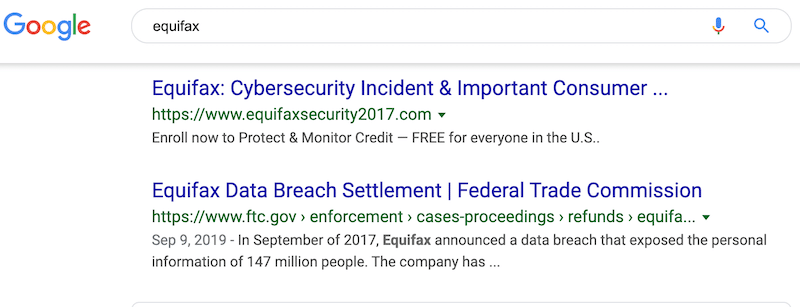Google has had its share of controversies over the past few years, but one of the biggest has been over its perceived ability to make or break the reputation of individuals and brands. Equifax, anyone?
As a result, the European Union has pursued “right to be forgotten” legislation to enable forcing Google to remove reputation-damaging results from search.
Brands that focus only on what shows up on the first page of Google for their name miss the bigger picture. Online reputation is really about brand sentiment. What do people think about your brand as a whole? This can’t be ignored, as at least one study shows consumer trust in brands is at an all-time low.
Consumer sentiment isn’t built on Google SERPs. In many cases, negative brand search results are the consequence of a chain of failures involving all marketing channels. Similarly, positive customer/prospect sentiment has to be driven by all channels, not just good SEO.
The truth is too many marketers are focused on what search engines think of their brands and not enough about how people actually perceive them. Despite the popularity of conspiracy theories, Google isn’t out to get your brand. But if there is enough negativity out there, it will eventually be reflected in search results. Google surfaces what’s most common (discussed or written) about your brand, whether that’s positive or negative.
Artificial Intelligence and Brand Reputation
One area that should get increasing attention from brands concerned about online reputation is the use of artificial intelligence to produce what are known as “deepfakes.” A deepfake is machine-produced media that looks and sounds so much like whatever or whomever it is simulating that viewers can’t tell the difference.
Shocked that President Obama would say that? Of course, he didn’t. The video was created with an impersonator supplying Obama’s voice. Why does it look like Obama is actually saying the words recorded by the voice actor? The video creators used an AI neural network to model Obama’s lip movements from actual videos so they could overlay his mouth into existing footage to exactly represent each syllable spoken by the actor.
Right now deepfake technology is of most concern to politicians and celebrities, but brands need to be paying attention to the potential it could have to damage their reputations. Imagine a video of a corporate CEO appearing to say something that causes Wall Street to panic and tank the company’s stock. By the time the fake is uncovered, the damage has been done.
But deepfake attacks for brands could be much more lowkey than that example. A disgruntled customer could doctor a video interaction with a company’s customer service representative to make it look like the CSR was being abusive. If that video goes viral, the reputation damage would be obvious, and most viewers of the video would probably never see any refutation you publish.
Brand Reputation and SEO
I noted previously that brand reputation isn’t solely a matter of what appears on the first page of Google in a search for your brand. However, that also can’t be ignored as search engines are still one of the first places people go to learn about a brand.
So how does brand reputation factor into SEO?
First off, Google doesn’t have a brand bias; it has a data bias. That is, Google promotes popular brands because their data tell them searchers want to see those brands in their results. Google has access to signals way beyond links and PageRank. All the talk, social interactions, media mentions, reviews etc. around a brand can be signals that tell a search engine how people value a brand.
In addition, Google has access to mobile device data and other information to find out what businesses we talk about most, and which ones we actually frequent with our physical presence. If there are two pizza parlors in town, it’s possible the one with the crappier website and fewer reviews could outrank the other if Google detects way more people coming back to the first one again and again.
For this reason, SEOs need to take a more holistic view, paying attention to all the marketing channels their companies use. The best SEO optimization in the world can’t stop the titanic effect a negatively-received TV ad can have on organic traffic. The recent Peloton ad backlash and resulting $1.5 billion loss in the company’s value are a textbook example.
Defense Against the Dark Arts
How can brands defend their reputations in the age of deepfakes?
1 The best defense is building a strong brand reputation through all channels
Why? If a great many people are favorably disposed toward a brand, they are likely to be more skeptical of anything that seems out of character for that brand. A major study showed that consumers are significantly more willing to defend purpose-driven brands over traditional brands. (Purpose-driven brands are those that are perceived as consistently operating out of convictions that match those of their audiences.)
2 Own your mistakes
What about when something horrendous is exposed? Even a well-loved brand can suffer great damage from a negative story that goes viral. The answer in those cases is to address the situation immediately and meaningfully.
An example of how not to do this? Once again, Peloton #ftw. Instead of acknowledging the ad’s tone-deafness, they doubled down on the message and in acknowledging the backlash merely expressed that “we’re disappointed in how some have misinterpreted this commercial.” Blaming your consumers for not understanding your message is never a good look.
The best response is always to apologize and accept responsibility. Be clear about the steps being taken to address or remedy the situation and to ensure it won’t happen in the future. Then get to work generating more positive news to replace the bad news.
3 Sell your values
Consumers care about your values more than your value proposition – and younger consumers even more so. Focus your content around your mission, your people and your values rather than your products or services. Create content that is helpful to your audience versus purely product-marketing driven.
Nike has done a great job of this in their advertising by boldly standing for equality and representation. It works for them because they are able to make a connection with the best values of athletic competition. While some critics predicted they were taking too big a risk, Nike’s sales figures proved the majority of their fans connected with these values, and rewarded the brand with their continued purchasing loyalty.
Dove connected better with its audience’s value by deciding to stop using models and retouched images. Instead, they featured real people with whom their audience could identify. Defying every convention of beauty product advertising, Dove proved this values-first approach pays off.
In traditional marketing, the value proposition of a brand was thought of as the best product at the best price. While those remain important, the brands that are winning long-term consumer loyalty are those that are putting the values of their customers and prospects out front. The key here is that the values being promoted by the brand have to align well with their target audience.
4 Live your values
Think about the Dove and Nike examples above, and any of the most successful values-based brand campaigns. In every case, these brands never told people what their values were. They didn’t brag about it. Instead, they showed the values by telling relatable stories that made heroes of others, not themselves.
For Nike, it was a sports professional willing to put his career on the line for what he believed in. For Dove, it was their actual customers, real people with everyday faces. For Gillette, it was men who refuse to conform to “traditional roles” that have been toxic to others.
But it’s not enough just to tell the right stories. To become a brand that people love so much they’ll question or defend an attack against you, you need to live those values in every aspect of business. If you say you value the environment, are your products from sustainable sources? If you tell stories about equality, do your hiring practices line up?
In the internet age it isn’t difficult for consumers to sniff out hypocrisy, so any brand reputation built on values has to be authentically reflected in the brand itself.
5 Learn to listen
To be sure your brand’s values are not only being communicated but actually resonate with audiences, listen to them. This is where social media, and various social listening tools, become invaluable. You should be optimizing for positive brand sentiment, not just search rankings.
Of course, social listening can also help alert you to any growing negativity about your brand before it gets out of hand. If there are competitors or detractors going after your brand, don’t take them on directly. Instead, spend extra time reinforcing the positives of your brand that counteract the claims of the detractors, and that reinforce the positive inclination your fans already have for you.
If you’ve done all the work described above in a way that has built genuine affinity with your advocates, it will be much harder for a competitor or other bad actor to form a credible assault on your brand. The best defense is a good offense. Keep your customers and their values at the center of your long-term brand building strategy.
Adapted from a podcast interview with the author










